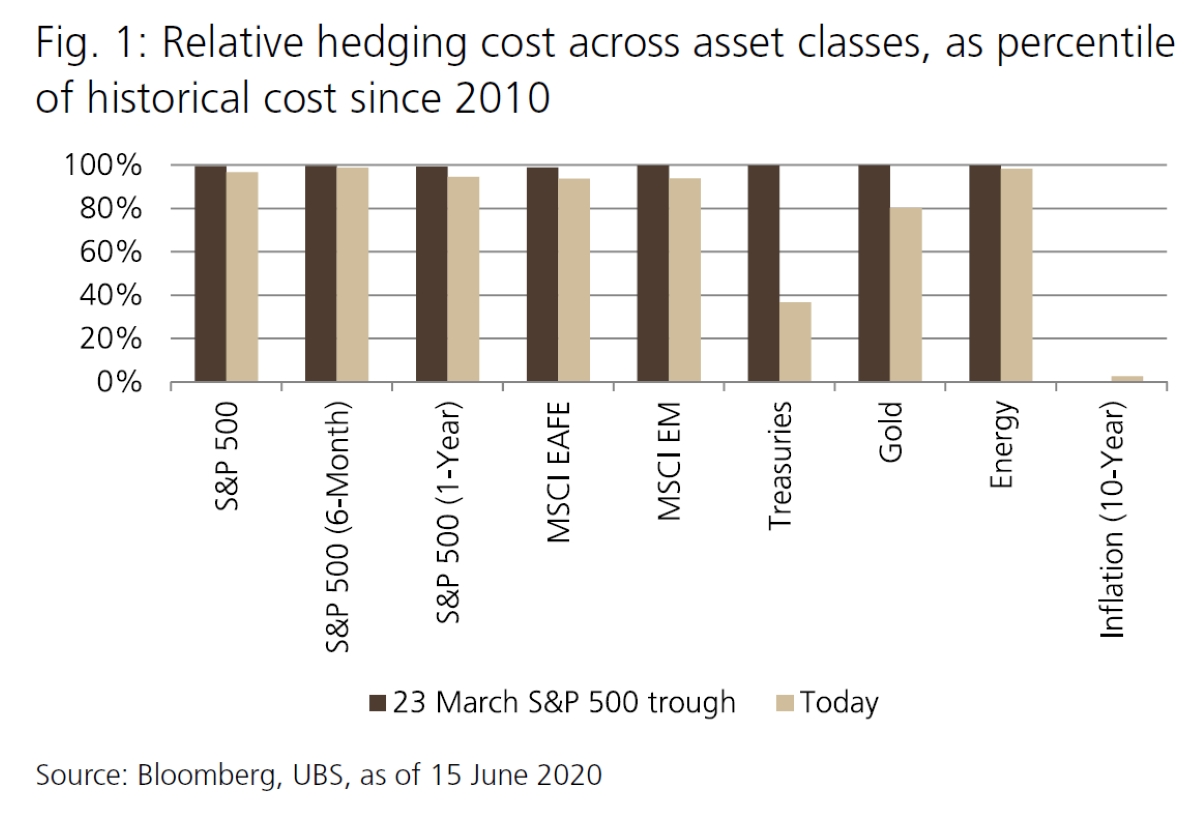

Finance
What Are The Hedging Strategies
Published: January 15, 2024
Learn about different hedging strategies in finance and how they can protect your investments. Understand how to mitigate risks and maximize returns with effective hedging techniques.
(Many of the links in this article redirect to a specific reviewed product. Your purchase of these products through affiliate links helps to generate commission for LiveWell, at no extra cost. Learn more)
Table of Contents
Introduction
When it comes to managing financial risks, hedging strategies play a crucial role in minimizing potential losses and optimizing investment outcomes. In today’s volatile and unpredictable market environment, it is essential for investors and businesses to have a solid understanding of hedging and the various strategies available to them.
Hedging is the practice of using financial instruments to offset or mitigate the risks associated with adverse price movements in an underlying asset. It is like an insurance policy that protects investors against potential losses. By implementing effective hedging strategies, individuals and businesses can safeguard their investments and navigate through uncertain market conditions more confidently.
The primary objective of hedging is not to generate profits, but rather to minimize losses and stabilize returns. It involves taking offsetting positions in different financial instruments, such as derivatives, to reduce or eliminate the impact of adverse price movements.
While hedging strategies are widely used in the financial industry, they are not limited to just investors and traders. Businesses across various sectors, including agriculture, manufacturing, and even airlines, rely on hedging to manage risks associated with fluctuations in commodity prices, exchange rates, interest rates, and more.
In this article, we will explore the concept of hedging in-depth, discuss the importance of using hedging strategies, and provide an overview of the different types of hedging strategies available to investors and businesses. We will also highlight the benefits and risks associated with hedging to help you make informed decisions in managing your financial risks.
What is Hedging?
Hedging is a risk management strategy employed by individuals, investors, and businesses to protect themselves against potential losses caused by adverse movements in the price of an underlying asset. It involves taking offsetting positions in related financial instruments to reduce or eliminate the risk of exposure to market fluctuations.
The main principle behind hedging is to create a counterbalancing position that will mitigate the impact of unfavorable price movements. By doing so, investors and businesses can protect their investments and limit potential losses, even if the market conditions turn against them.
Essentially, hedging is like having an insurance policy for your investments. You pay a premium to protect yourself against a potential loss, just as you would pay for insurance coverage to protect your home or car. This provides a sense of security and peace of mind for investors, knowing that they have measures in place to manage and control risk.
To implement a hedging strategy, individuals and businesses use derivative contracts, such as options, futures, forwards, and swaps. These contracts derive their value from an underlying asset, such as stocks, commodities, currencies, or interest rates. By taking a position in these derivatives, investors can offset the potential losses in the underlying asset.
It’s important to note that hedging does not guarantee profits or prevent losses entirely. Instead, it aims to minimize the impact of adverse price movements, allowing investors and businesses to manage their risk exposure more effectively.
Overall, hedging is a crucial tool in risk management, providing a way for individuals and businesses to protect themselves against market uncertainties. It allows them to navigate turbulent market conditions with more confidence, knowing that they have taken necessary measures to mitigate potential losses.
Why Use Hedging Strategies?
Hedging strategies are employed for several reasons, all aimed at managing and mitigating financial risks. Let’s explore some of the key reasons why individuals, investors, and businesses use hedging strategies:
- Minimize Potential Losses: The primary objective of hedging is to minimize potential losses caused by adverse price movements. By taking offsetting positions in related financial instruments, investors can protect their investments and limit downside risk. This is particularly important in volatile or uncertain market conditions.
- Diversification: Hedging strategies provide a way to diversify an investment portfolio. By incorporating different hedging techniques across various asset classes, investors can spread their risk and reduce their exposure to any single asset. This helps in achieving a more balanced and resilient portfolio.
- Preserve Capital: Hedging allows investors and businesses to preserve capital by protecting the value of their assets. By hedging against potential losses, they can ensure that their capital is intact even in challenging market conditions.
- Stabilize Cash Flows: Businesses often use hedging strategies to stabilize their cash flows by mitigating the impact of fluctuations in commodity prices, exchange rates, or interest rates. This helps in managing costs, budgeting, and planning more effectively.
- Reduce Uncertainty: Hedging strategies provide a sense of certainty and predictability in an uncertain market environment. By having measures in place to manage risk, investors and businesses can make more informed decisions and have greater confidence in their financial positions.
- Competitive Advantage: Implementing effective hedging strategies can give businesses a competitive advantage by protecting them from volatile market conditions. It allows them to focus on their core operations rather than being constantly exposed to market risk.
Overall, hedging strategies offer a range of benefits, including risk reduction, portfolio diversification, capital preservation, and increased stability. By employing hedging techniques, individuals and businesses can navigate through market uncertainties with greater confidence and protect themselves against potential losses.
Types of Hedging Strategies
There are various types of hedging strategies available to investors and businesses, each designed to mitigate specific risks associated with different asset classes. Let’s explore some of the most commonly used hedging strategies:
- Forward Contracts: A forward contract is an agreement to buy or sell an asset at a predetermined price at a future date. It helps in hedging against price fluctuations by locking in the current price, thereby protecting against potential losses due to adverse movements in the market.
- Options Contracts: Options contracts give the holder the right, but not the obligation, to buy or sell an asset at a predetermined price within a specified timeframe. Options can be used as a hedging tool to protect against downside risk while allowing for potential upside gains.
- Futures Contracts: Futures contracts are similar to forward contracts but are standardized and traded on exchanges. They enable investors to buy or sell an asset at a predetermined price on a specified future date. Futures contracts are often used for hedging commodities, currencies, and other assets.
- Swaps: Swaps involve the exchange of cash flows between two parties based on underlying financial instruments. They are commonly used for hedging interest rate risk, foreign exchange risk, and commodity price risk. Swaps help in managing cash flow uncertainties and reducing exposure to market fluctuations.
- Currency Hedging: Currency hedging strategies are employed to mitigate the impact of fluctuations in foreign exchange rates. This is particularly important for businesses engaged in international trade, as it helps protect against exchange rate volatility and ensures stability in cross-border transactions.
- Commodity Hedging: Commodity hedging is used by producers, consumers, and investors to manage risks associated with price fluctuations in commodities such as oil, gas, metals, and agricultural products. It involves taking positions in derivative contracts or using futures contracts to protect against commodity price volatility.
- Interest Rate Hedging: Interest rate hedging strategies are employed to manage risks associated with changes in interest rates. Businesses and investors may use interest rate swaps or futures contracts to hedge against fluctuations in borrowing costs or to lock in fixed interest rates.
- Equity Hedging: Equity hedging strategies involve using derivatives, such as options or futures contracts, to mitigate risks associated with changes in stock prices. Investors can use these strategies to protect against potential losses in their equity portfolio while maintaining exposure to potential gains.
These are just a few examples of the extensive range of hedging strategies available. The choice of strategy depends on the specific risks, asset classes, and objectives of the investor or business. It is important to carefully analyze and select the most suitable hedging strategy to effectively manage and mitigate risk exposure.
Forward Contracts
Forward contracts are a type of financial agreement between two parties to buy or sell an asset at a predetermined price on a specified future date. They are commonly used for hedging purposes to protect against price fluctuations in various asset classes, including currencies, commodities, and securities.
Forward contracts are highly customizable, allowing the parties involved to negotiate and agree on the specific terms of the contract. This includes the underlying asset, the contract size, the price, and the delivery or settlement date. By locking in the current price through a forward contract, investors can protect themselves against potential losses resulting from unfavorable price movements.
For example, suppose a manufacturer knows that they will need a certain amount of steel in six months to fulfill their production needs. However, they are concerned about the volatility in steel prices. To mitigate the risk of increased costs due to rising steel prices, the manufacturer can enter into a forward contract with a steel supplier. The forward contract specifies the quantity of steel to be purchased, the price, and the delivery date. By entering into this agreement, the manufacturer locks in the current steel price, ensuring a fixed cost and protecting against potential price increases.
Forward contracts are useful for businesses and investors who are exposed to price volatility in the market. They provide a way to hedge against potential losses and provide certainty in financial transactions. However, it’s important to note that forward contracts carry counterparty risk, as both parties are obligated to fulfill the terms of the contract at the agreed-upon future date. Therefore, it’s crucial to choose reliable and trustworthy counterparties when entering into forward contracts.
In summary, forward contracts are a popular hedging strategy that allows investors and businesses to protect themselves against potential losses caused by price fluctuations. By locking in the current price through a forward contract, individuals and organizations can manage their risk exposure and have more stability in their financial transactions.
Options Contracts
Options contracts are versatile financial instruments that provide the holder with the right, but not the obligation, to buy or sell an underlying asset at a predetermined price within a specified timeframe. Options are commonly used for hedging purposes, allowing investors and traders to protect themselves against potential losses resulting from adverse market movements.
There are two types of options contracts: call options and put options. A call option gives the holder the right to buy the underlying asset at the predetermined price, known as the strike price, before or on the expiration date. On the other hand, a put option gives the holder the right to sell the underlying asset at the strike price.
Options contracts offer flexibility and allow investors to tailor their hedging strategies to their specific needs. They can be used to limit downside risk while allowing for potential upside gains. By purchasing put options, investors can protect the value of their assets in case of a decline in prices. Conversely, call options can be used to protect against potential losses caused by a rise in prices.
For example, suppose an investor holds a portfolio of stocks and believes that the market may experience a decline in the near future. To hedge against potential losses, the investor can purchase put options on the stocks within their portfolio. In the event of a market downturn, the put options will increase in value, offsetting the losses incurred in the stock portfolio.
Options contracts also provide opportunities for speculative trading and income generation through option writing, but these strategies come with higher risk and require a deep understanding of market dynamics and option pricing.
It’s important to note that options contracts have an expiration date, after which they become worthless. Therefore, timing is crucial when using options for hedging purposes. Additionally, options have an upfront cost known as the premium, which is the price paid to acquire the options contract. This premium represents the maximum potential loss for the holder of the option.
In summary, options contracts are a popular hedging tool used to protect against potential losses caused by market fluctuations. They offer flexibility, allowing investors to tailor their hedging strategies to their specific needs and risk tolerance. However, options trading requires careful consideration and understanding of the underlying assets and market dynamics to effectively manage risk and optimize returns.
Futures Contracts
Futures contracts are standardized financial agreements to buy or sell an underlying asset at a predetermined price on a specified future date. They are widely used by investors and traders as a hedging tool to manage and mitigate risks associated with price fluctuations in various asset classes, including commodities, currencies, and financial instruments.
Unlike forward contracts, which are customized and traded over-the-counter, futures contracts are exchange-traded and have standardized terms and conditions. They provide transparency, liquidity, and ease of trading, making them accessible to a wide range of market participants.
Futures contracts serve as a hedging mechanism by allowing market participants to lock in the current price of the underlying asset. This protects against potential losses resulting from adverse price movements. By entering into a futures contract, the buyer agrees to purchase the asset at the predetermined price, while the seller agrees to sell it at that price on the specified future delivery date.
For example, let’s say a coffee producer anticipates that the price of coffee beans will decrease in the coming months. To hedge against potential losses, the producer can enter into a futures contract with a buyer. The futures contract specifies the quantity of coffee beans, the price, and the delivery date. By doing so, the coffee producer locks in the current price, protecting against a decline in the market value of coffee beans.
Futures contracts are often used by businesses and investors to manage price risks associated with commodities or other assets. They provide a way to stabilize costs, manage inventory, and ensure predictability in financial transactions.
It’s important to note that futures contracts have standardized sizes, delivery dates, and settlement procedures. They also require margin deposits, which act as collateral to cover potential losses and ensure the integrity of the contract. These margin requirements make futures trading capital-intensive and involve a higher level of risk compared to other hedging strategies.
In summary, futures contracts are exchange-traded financial instruments that allow market participants to hedge against potential losses caused by price fluctuations in various asset classes. They provide transparency, liquidity, and effective risk management tools for businesses and investors. However, proper risk management and understanding of the underlying market dynamics are essential when using futures contracts for hedging purposes.
Swaps
Swaps are derivative contracts that involve the exchange of cash flows or liabilities between two parties based on specific financial instruments. They are widely used as hedging strategies to manage risks related to interest rates, foreign exchange rates, and commodities.
Swaps are customizable agreements negotiated between the parties involved, commonly known as counterparties. These agreements outline the terms and conditions of the swap, including the reference rate, notional principal amount, payment frequency, and maturity date.
The most common type of swap is an interest rate swap, where two parties exchange fixed and floating-rate cash flows based on a specific notional principal amount. This allows entities to manage their exposure to fluctuating interest rates and stabilize cash flows. For example, a company with a variable-rate loan can enter into an interest rate swap to exchange the variable interest payments for fixed interest payments, providing certainty and protection against rising interest rates.
Currency swaps are another type of swap commonly used to manage foreign exchange rate risk. In a currency swap, two parties exchange principal amounts in different currencies while agreeing to exchange periodic interest payments. Currency swaps are valuable for businesses engaged in international trade or handling foreign investments, as they provide a way to hedge against currency fluctuations and achieve stability in cash flows.
Commodity swaps allow participants to manage risks associated with fluctuations in commodity prices. For example, a producer of crude oil can enter into a commodity swap agreement to fix the selling price of their oil in order to protect against potential declines in the market price. This provides stability and predictability in revenue even in a volatile market environment.
Swaps are typically facilitated by financial institutions or specialized swap dealers and are often executed over-the-counter (OTC). As OTC instruments, swaps are subject to credit risk, as the performance of the contract relies on the financial stability and integrity of the counterparties involved.
Swaps are effective hedging tools as they allow entities to manage specific risks associated with interest rates, foreign exchange rates, and commodities. By entering into a swap agreement, market participants can mitigate exposure to volatility, stabilize cash flows, and achieve risk management objectives. However, it is important to carefully consider the terms and counterparties involved when utilizing swaps as hedging strategies.
Currency Hedging
Currency hedging is a risk management strategy used to mitigate potential losses caused by fluctuations in foreign exchange rates. Currency movements can have a significant impact on the financial positions of businesses engaged in international trade or individuals holding investments denominated in foreign currencies. Currency hedging strategies aim to protect against these risks and provide stability in cross-border transactions.
There are several currency hedging techniques available, depending on the specific needs and objectives of the hedging party:
- Forward Contracts: Forward contracts are commonly used for currency hedging. They allow businesses and investors to lock in an exchange rate for a future transaction. By entering into a forward contract, the parties agree to buy or sell a specific amount of currency at a predetermined rate on a specified future date. This helps protect against adverse currency movements and provides certainty in international transactions.
- Currency Options: Currency options provide the right, but not the obligation, to buy or sell a specific amount of currency at a predetermined exchange rate within a specified timeframe. Currency options allow hedgers to protect against unfavorable currency movements while still having the flexibility to participate in favorable movements. They offer more strategic and tailored hedging solutions compared to forward contracts.
- Currency Futures: Currency futures are standardized contracts traded on exchanges that allow market participants to buy or sell a specific currency at a predetermined price and future date. They provide a transparent and regulated platform for currency hedging, enabling market participants to protect against currency risk.
- Foreign Exchange Swaps: Foreign exchange swaps involve the simultaneous purchase and sale of two different currencies with a pre-agreed exchange rate and maturity date. They allow hedgers to manage their currency exposure over a specific period, providing flexibility in hedging strategies.
Currency hedging is particularly important for businesses involved in international trade, as it helps mitigate the impact of currency fluctuations on import or export costs, revenue, and profits. By hedging currency exposure, businesses can maintain more stable pricing, accurately forecast cash flows, and eliminate the risk of currency-related losses.
Individual investors holding assets denominated in foreign currencies can also benefit from currency hedging. Hedging can protect against potential losses caused by unfavorable exchange rate movements when converting foreign currency investments back into the domestic currency.
However, it’s important to note that currency hedging strategies come with their own costs and considerations. Hedging transactions may involve additional fees, commissions, or spreads. Additionally, there is always the risk of hedging strategies not providing the desired outcome if currency movements differ from expectations.
In summary, currency hedging is a risk management technique used to protect against potential losses resulting from fluctuations in foreign exchange rates. Various hedging instruments, such as forward contracts, options, futures, and swaps, provide businesses and investors with the tools and flexibility to manage currency risk effectively. By employing currency hedging strategies, market participants can stabilize cash flows, mitigate volatility, and maintain greater certainty in their international financial transactions.
Commodity Hedging
Commodity hedging is a risk management strategy used to mitigate potential losses caused by fluctuations in commodity prices. Commodities, such as oil, gas, metals, agricultural products, and other raw materials, can experience significant volatility due to various factors such as supply and demand dynamics, geopolitical events, and weather conditions. Commodity hedging strategies aim to protect businesses and investors from price fluctuations and secure stable revenue streams.
There are various techniques and instruments employed for commodity hedging:
- Futures Contracts: Futures contracts are widely used for commodity hedging. They allow market participants to buy or sell a specified quantity of a commodity at a predetermined price and future date. By entering into futures contracts, businesses can lock in prices and protect against potential losses resulting from adverse movements in commodity prices.
- Options Contracts: Options contracts provide the right, but not the obligation, to buy or sell a commodity at a predetermined price within a specified timeframe. Options allow for more flexibility in hedging strategies. For example, a producer can purchase a put option to protect against a decline in commodity prices while still benefiting from potential price increases.
- Commodity Swaps: Commodity swaps involve the exchange of cash flows based on the price of a specific commodity. Parties agree to exchange periodic payments based on the commodity’s price index, providing a way to hedge against price fluctuations.
- Exchange-Traded Funds (ETFs): Commodity-specific exchange-traded funds allow investors to gain exposure to specific commodities or commodity indices. Investing in commodity ETFs can provide diversification and hedging opportunities for investors looking to mitigate commodity price risks.
Commodity hedging is particularly important for businesses involved in commodity production, trading, or consumption. Producers often face the risk of declining commodity prices, which can erode profitability. By implementing hedging strategies, such as entering into futures contracts, producers can secure a predetermined selling price, ensuring stable revenue and protecting against potential losses.
Consumers and manufacturers also utilize commodity hedging to manage their exposure to volatile input prices. By hedging against potential price increases, they can control costs and plan production budgets more effectively.
Investors interested in commodity markets can utilize hedging strategies to minimize risk and optimize portfolio performance. By incorporating commodities or commodity-related instruments into their portfolios, investors can achieve diversification and hedge against potential inflationary pressures.
However, it’s important to note that commodity hedging does not guarantee profits or eliminate all risks associated with commodity price movements. Hedging transactions may involve costs such as fees, spreads, or margin requirements. Additionally, effective commodity hedging requires a good understanding of market dynamics, fundamental factors, and risk management techniques.
In summary, commodity hedging is a risk management approach used to mitigate potential losses resulting from fluctuations in commodity prices. Through the use of futures contracts, options contracts, swaps, or commodity ETFs, businesses and investors can protect themselves against price volatility, stabilize revenue streams, and optimize portfolio performance in commodity markets.
Interest Rate Hedging
Interest rate hedging is a risk management strategy employed by businesses and investors to protect against fluctuations in interest rates. Changes in interest rates can have a significant impact on borrowing costs, investment returns, and cash flows. Interest rate hedging strategies aim to mitigate these risks and provide stability in interest-related financial transactions.
There are various interest rate hedging techniques used in the market:
- Interest Rate Swaps: Interest rate swaps are commonly used for hedging interest rate risk. In an interest rate swap, two parties agree to exchange periodic interest payments based on a specific notional principal amount. Swaps allow entities to manage exposure to floating or fixed interest rates, providing certainty in interest costs or returns.
- Interest Rate Futures: Interest rate futures contracts are exchange-traded derivatives that involve the buying or selling of a financial instrument based on an underlying interest rate. They allow market participants to hedge or speculate on interest rate movements.
- Forward Rate Agreements (FRAs): FRAs are over-the-counter contracts that allow parties to lock in an interest rate for a future period. They are commonly used when there is uncertainty about future interest rates, enabling entities to hedge against interest rate fluctuations.
- Interest Rate Options: Interest rate options provide the holder with the right, but not the obligation, to buy or sell an interest rate futures contract or a specific bond at a predetermined price within a specified timeframe. They offer flexibility in hedging strategies, allowing investors to protect against adverse interest rate movements while still participating in potential favorable rate changes.
Interest rate hedging is crucial for businesses and investors with exposure to interest rate fluctuations. For example, businesses with variable-rate loans may employ interest rate swaps to convert their floating-rate payments into fixed-rate payments, protecting against potential increases in borrowing costs. Similarly, investors holding fixed-income securities may use interest rate futures or options to hedge against declines in bond prices resulting from rising interest rates.
Financial institutions, such as banks, also engage in interest rate hedging to manage risks associated with their interest-sensitive assets and liabilities. This allows them to maintain a balanced interest rate position and protect against adverse shifts in market rates.
It’s important to note that interest rate hedging comes with its own considerations and risks. Hedging transactions may involve costs, such as bid-ask spreads, margin requirements, or fees. Additionally, correctly timing hedging transactions and accurately assessing interest rate movements require careful analysis and expertise.
In summary, interest rate hedging is a risk management strategy used to protect against interest rate fluctuations. By employing interest rate swaps, futures, FRAs, or options, entities can manage their exposure to changing interest rates, stabilize cash flows, and protect against potential losses. However, it’s crucial to carefully evaluate and understand the associated costs and risks when implementing interest rate hedging strategies.
Equity Hedging
Equity hedging is a risk management strategy used by investors, traders, and businesses to protect against potential losses in equity investments. Equity refers to ownership interests in companies, typically in the form of stocks or shares. Equity prices can be volatile, driven by various factors such as market conditions, company performance, and investor sentiment. Equity hedging strategies aim to mitigate these risks and provide stability in equity portfolios.
There are several equity hedging techniques available:
- Put Options: Put options are commonly used for equity hedging. They provide the holder with the right, but not the obligation, to sell a specified amount of a stock or an equity index at a predetermined price within a specified timeframe. Put options allow investors to protect against potential losses in their equity holdings by locking in a price at which they can sell if the market declines.
- Futures Contracts: Equity index futures contracts are exchange-traded derivatives that allow investors to hedge against declines in equity markets. By selling index futures contracts, investors can offset potential losses in their equity portfolios if the market goes down.
- Short Selling: Short selling is a technique where an investor borrows shares of a stock and sells them, with the intention of buying them back later at a lower price. Short selling allows investors to profit from a decline in stock prices and can act as a hedge against existing long positions.
- Exchange-Traded Funds (ETFs): Equity-related ETFs allow investors to gain exposure to specific sectors, industries, or indices. By incorporating ETFs into their portfolios, investors can achieve diversification and hedge against potential losses in specific areas of the equity market.
Equity hedging is valuable for investors and businesses looking to protect their investments from downside risk. Hedging allows them to limit potential losses while still maintaining exposure to potential gains. This is particularly important during periods of market volatility or when holding concentrated stock positions.
Businesses also engage in equity hedging to manage risks related to employee stock options or equity-based compensation programs. By implementing hedging strategies, companies can mitigate the impact of stock price fluctuations and ensure financial stability.
It’s important to note that equity hedging strategies come with their own considerations and risks. Hedging transactions may involve costs such as option premiums, trading fees, or margin requirements. Additionally, the effectiveness of equity hedging may depend on factors such as market conditions, timing of trades, and the correlation between the hedge instrument and the underlying equities.
In summary, equity hedging is a risk management strategy used to protect against potential losses in equity investments. Techniques such as put options, futures contracts, short selling, or ETFs allow investors and businesses to mitigate downside risk and achieve greater stability in equity portfolios. However, it’s important to carefully assess the costs, risks, and effectiveness of equity hedging strategies in relation to individual investment goals and market conditions.
Benefits of Hedging Strategies
Hedging strategies offer several benefits to investors, businesses, and individuals seeking to manage financial risks. Let’s explore some of the key advantages of implementing hedging strategies:
- Risk Management: Hedging strategies allow entities to effectively manage and mitigate risks associated with price fluctuations in various asset classes. By taking offsetting positions or utilizing derivative contracts, individuals and businesses can protect themselves against potential losses, providing a sense of stability and security.
- Preservation of Capital: Hedging helps in preserving capital by reducing the impact of adverse market movements. By ensuring a minimum level of returns or limiting potential losses, hedging strategies provide a safeguard for investments and help maintain the value of capital.
- Flexibility and Customization: Hedging strategies can be tailored to individual needs and objectives. Various hedging instruments, such as options, futures, and swaps, offer a range of choices to suit different risk profiles, time horizons, and asset classes. This flexibility allows entities to design hedging strategies that align with their specific requirements.
- Enhanced Decision-Making: Implementing hedging strategies provides entities with a clearer picture of their financial positions and potential outcomes. By having measures in place to manage risk, individuals and businesses can make informed decisions, confidently pursue opportunities, and effectively allocate resources.
- Diversification: Hedging strategies provide diversification benefits by offsetting risks in different asset classes. By spreading risk across various investments or using different hedging techniques, entities can reduce their exposure to any single asset or market. This enhances portfolio stability and helps achieve a balanced risk-return profile.
- Competitive Advantage: Hedging strategies can provide a competitive advantage in the market. By effectively managing risks, businesses can focus on their core operations, make strategic decisions with greater confidence, and become more resilient to fluctuations in prices, interest rates, or currency exchange rates.
- Stability in Cash Flows: For businesses, hedging strategies help stabilize cash flows by reducing uncertainties associated with price fluctuations, interest rate changes, or currency movements. This allows for better financial planning, budgeting, and allocation of resources.
Overall, implementing hedging strategies offers numerous benefits, including risk reduction, preservation of capital, customization options, enhanced decision-making, diversification, competitive advantage, and stability in cash flows. These advantages provide entities with a solid foundation to navigate through market uncertainties, protect investments, and optimize financial outcomes.
Risks and Limitations of Hedging
While hedging strategies offer numerous benefits, it is important to recognize the risks and limitations associated with these risk management techniques. Understanding these factors can help individuals and businesses make informed decisions when implementing hedging strategies. Here are some key risks and limitations to consider:
- Costs and Fees: Hedging transactions often involve costs and fees, such as premiums, spreads, or commissions. These expenses can impact overall returns and should be carefully evaluated in relation to the potential risk reduction provided by the hedging strategy.
- Market Timing: Successfully timing hedging transactions can be challenging. Making accurate predictions about future market movements is difficult, and incorrect timing can result in ineffective hedges or missed opportunities. It is essential to consider the potential volatility and dynamics of the specific market being hedged.
- Counterparty Risk: Hedging instruments often require engagement with counterparties, such as financial institutions or other parties involved in the transactions. Counterparty risk arises when the counterparty fails to honor its obligations, leading to potential financial losses or failed hedging transactions. It is crucial to choose reliable and creditworthy counterparties.
- Over-Hedging or Under-Hedging: Accurately determining the appropriate amount of hedging can be challenging. Over-hedging can result in missed opportunities for gains, while under-hedging may leave an entity vulnerable to excessive risks. Finding the right balance is crucial and requires considering factors such as risk tolerance, market conditions, and investment objectives.
- Regulatory and Compliance Risks: Hedging strategies may be subject to regulatory oversight and compliance requirements. Entities must stay informed and ensure that their hedging activities adhere to applicable laws and regulations. Failure to comply can result in legal and financial consequences.
- Effectiveness of Hedging: Hedging strategies may not always provide the desired level of protection or risk reduction. Factors such as basis risk, imperfect correlation between the hedging instrument and the underlying asset, or unexpected market conditions can impact the effectiveness of the hedge. Entities should regularly monitor and evaluate the performance of their hedging strategies.
- Opportunity Costs: Hedging involves potentially sacrificing opportunities for greater profits. While hedging protects against downside risk, it also limits potential gains that could have been earned if the market had moved favorably. Entities should carefully weigh the benefits of risk reduction against potential missed opportunities.
It is important to recognize that hedging strategies, although valuable risk management tools, do not eliminate risk entirely. They aim to reduce and manage risks, but they cannot provide complete protection against all market fluctuations or unforeseen events.
In summary, hedging strategies come with risks and limitations that need to be carefully evaluated. Costs and fees, market timing challenges, counterparty risk, the possibility of over-hedging or under-hedging, regulatory considerations, the effectiveness of hedging, opportunity costs, and the inability to eliminate risk entirely are important factors to consider. Through comprehensive risk assessment and ongoing monitoring, entities can better navigate the potential pitfalls of hedging and make informed decisions to protect against adverse market movements.
Conclusion
Hedging strategies play a vital role in managing financial risks and protecting investments and businesses from adverse market movements. Whether through forward contracts, options contracts, futures contracts, swaps, or other hedging instruments, entities can mitigate the impact of price fluctuations, interest rate changes, currency volatility, and commodity price swings.
The benefits of implementing hedging strategies are numerous. They provide risk management, capital preservation, flexibility, enhanced decision-making, diversification, competitive advantage, and stability in cash flows. Hedging allows entities to navigate uncertain market conditions with more confidence, protect against potential losses, and optimize their financial outcomes.
However, it is important to acknowledge the risks and limitations associated with hedging. Costs and fees, the challenge of market timing, counterparty risk, the potential for over-hedging or under-hedging, regulatory compliance concerns, the effectiveness of hedging, and opportunity costs are factors that need to be carefully evaluated and monitored.
Successful implementation of hedging strategies requires a deep understanding of market dynamics, risk exposure, and hedging instruments. Entities should perform comprehensive risk assessments, consider their risk appetite and investment objectives, and continually monitor the performance of their hedging strategies.
In conclusion, hedging strategies provide a valuable tool for managing financial risks and optimizing investment and business outcomes. With careful consideration of risks, costs, benefits, and ongoing monitoring, entities can effectively navigate through market uncertainties, protect their investments, and achieve greater stability in their financial positions.














